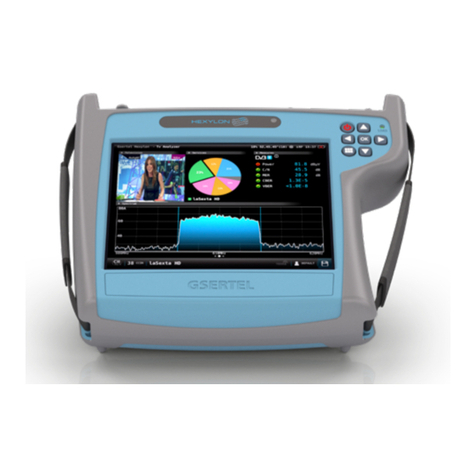
RCS User Manual
3
3.5.- Tree View........................................................................................................................................ 56
3.6.- Service Monitoring-Option 902558-............................................................................................ 57
3.7.- RDS Analysis –Only for RCS100 and RCS400-....................................................................... 57
3.8.- TS Recorder................................................................................................................................... 58
3.9.- Quality of Service –Option 902538. Only for RCS100 and RCS400-.................................... 60
4.- T2-MI Analysis -Option 902513 only for RCS100 and RCS400-................................................... 61
4.1.- Bitrate.............................................................................................................................................. 61
4.2.- Packet Analysis.............................................................................................................................. 61
4.3.- TS Recorder................................................................................................................................... 63
4.4.- T2MI Templates –Only for RCS100 and RCS400- .................................................................. 64
5.- RF Analysis............................................................................................................................................ 66
5.1.- Measurements................................................................................................................................ 66
5.2.- Constellation -Option 902511 only for RCS100 and RCS400-............................................... 67
5.3.- Echoes............................................................................................................................................. 68
5.4.- DVBT2 Templates –Only for RCS100 and RCS400-............................................................... 70
5.5.- SFN -Option 902511 and 902518 only for RCS100 and RCS400-........................................ 71
5.6.- Channel Spectrum –Only for RCS50-............................................................................................ 73
6.- Spectrum -Option 902511 only for RCS100 and RCS400-............................................................ 74
7.- Polling..................................................................................................................................................... 77
7.1.- Polling.............................................................................................................................................. 77
7.2.- Historical Pollings .......................................................................................................................... 79
7.3.- Configuration.................................................................................................................................. 81
8.- Alarms..................................................................................................................................................... 83
8.1.- View................................................................................................................................................. 83
9.- Historical................................................................................................................................................. 84
10.- Network Delay -Option 902512 only for RCS100 and RCS400-................................................. 87
Local Features................................................................................................................................................. 88
Maintenance.................................................................................................................................................... 90
Technical Support........................................................................................................................................... 92
Warranty........................................................................................................................................................... 93
Annex 1. Introduction to SNMP.................................................................................................................... 95
Annex 2. Alarms Definitions........................................................................................................................ 101






























